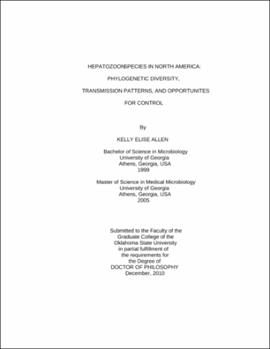| dc.contributor.advisor | Little, Susan E. | |
| dc.contributor.advisor | Johnson, Eileen M. | |
| dc.contributor.author | Allen, Kelly Elise | |
| dc.date.accessioned | 2013-11-26T08:35:11Z | |
| dc.date.available | 2013-11-26T08:35:11Z | |
| dc.date.issued | 2010-12 | |
| dc.identifier.uri | https://hdl.handle.net/11244/7646 | |
| dc.description.abstract | The research presented in this dissertation was conducted to better understand the Hepatozoon species present in vertebrates in the United States. In Chapter 3, Hepatozoon spp. infecting domestic dogs in Oklahoma were genetically characterized using a hypervariable region of the 18S rRNA gene. A surprising degree of diversity was revealed in the amplicon sequences compared, suggesting multiple strains of Hepatozoon americanum or species of Hepatozoon not yet genetically characterized are cycling in dogs in the United States. In this chapter, Hepatozoon spp. genetic sequence data most identical to those of Hepatozoon canis are reported in dogs for the first time in North America. The second study (Chapter 4) was a pilot trial conducted to evaluate the efficacy of ponazuril (toltrazuril sulfone) treatment in a dog experimentally infected with H. americanum to assess parasite clearance and clinical improvement of the infected dog. Although possibly responsible for the dog's clinical improvement, ponazuril treatment did not clear the animal of H. americanum as evidenced by PCR and microscopic detection of parasite in muscle tissue samples harvested at necropsy. Chapter 5 of this dissertation presents a study conducted to genetically characterize Hepatozoon spp. infecting various vertebrate host species, known and previously unrecognized, in the southern United States. Hepatozoon spp. 18S rDNA was amplified by PCR from whole blood or tissue samples collected from 16 different vertebrate species from Oklahoma, Missouri, Georgia, Texas, or the southern portion of California. Hepatozoon spp. sequence comparisons revealed phylogenetic relationships indicative of predator/prey patterns, with possible transmission cycles apparent between canids and rabbits and snakes and rodents. Another interesting finding from this study was that a sequence from a gray fox in Georgia was most identical to a sequence previously reported as H. canis from a domestic dog in Spain. Lastly, the research presented in Chapter 6 describes an experiment designed to assess the occurrence of transplacental transmission of H. americanum in a chronically infected dam. Seven pups whelped from a dam experimentally infected with H. americanum in a chronic phase of disease were monitored for circulating parasite by PCR and xenodiagnosis. Pups remained free of clinical signs throughout the study, were negative by PCR at all bleed dates, and did not infect Amblyomma maculatum in the xenodiagnostic experiment conducted 12 weeks post whelping. | |
| dc.format | application/pdf | |
| dc.language | en_US | |
| dc.rights | Copyright is held by the author who has granted the Oklahoma State University Library the non-exclusive right to share this material in its institutional repository. Contact Digital Library Services at lib-dls@okstate.edu or 405-744-9161 for the permission policy on the use, reproduction or distribution of this material. | |
| dc.title | Hepatozoon species in North America: Phylogenetic diversity, transmission patterns, and opportunities for control | |
| dc.contributor.committeeMember | Reichard, Mason V. | |
| dc.contributor.committeeMember | Shaw, Edward I. | |
| osu.filename | Allen_okstate_0664D_11148 | |
| osu.accesstype | Open Access | |
| dc.type.genre | Dissertation | |
| dc.type.material | Text | |
| thesis.degree.discipline | Veterinary Pathobiology | |
| thesis.degree.grantor | Oklahoma State University | |
